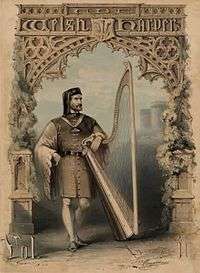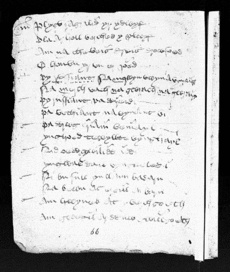The Girls of Llanbadarn

"The Girls of Llanbadarn", or "The Ladies of Llanbadarn" (Welsh: Merched Llanbadarn), is a short, wryly humorous poem[1] by the 14th-century Welsh poet Dafydd ap Gwilym, in which he mocks his own lack of success with the girls of his neighbourhood. Dafydd is widely seen as the greatest of the Welsh poets,[2][3][4][5] and this is one of his best-known works.[6][7] The poem cannot be precisely dated, but was perhaps written in the 1340s.[8]
Summary
Dafydd curses the women of his parish, and complains that he has never had any luck with any of them. He wonders what is lacking in him or in them that none of them will agree to meet him in the woods. Comparing himself to Garwy he says that he has always been in love with some girl or other but never won her, and confesses that every Sunday he can be found in church, with his head turned over his shoulder and away from the body of Christ, gazing at some girl. Dafydd represents such a woman as exchanging with her friend gibes about his appearance and character. The poet concludes that he must give all this up and go off alone to be a hermit, since, though his ogling habits have literally turned his head, he still has no girl.
Commentary
Dafydd often refers to Llanbadarn in his poems, reflecting the fact that he was born at Brogynin, in the parish of Llanbadarn Fawr, and lived there for many years.[9] He shows his knowledge of Welsh legend with his reference to Garwy Hir, who was renowned as a lover, and whose daughter was herself loved by King Arthur.[10][11] The line in which the poet is said to be "Pale and with his sister's hair"[12] are consistent with a third-hand description of Dafydd given in a 16th-century document: "tall and slender, with long curly yellow hair, full of silver clasps and rings".[13] It has been suggested that the first of Dafydd's two disparagers is the woman whom in many other poems he calls Morfudd, the object of his often rejected devotion.[14][15]
Theme and analogues

The poem's theme, Dafydd's habitual failure in love, is a very common one in his work. As the novelist and scholar Gwyn Jones wrote:
No lover in any language, and certainly no poet, has confessed to missing the mark more often than Dafydd ap Gwilym. Uncooperative husbands, quick-triggered alarms, crones and walls, strong locks, floods and fogs and bogs and dogs are for ever interposing themselves between him and golden-haired Morfudd, black-browed Dyddgu, or Gwen the infinitely fair. But a great trier, even in church.[16]
Parallels to Dafydd's amused and ironic reportage of his own inadequacies can be found in Chaucer's works, and elsewhere in medieval literature; also in the poems of Dafydd's avowed model Ovid.[17] But Dafydd is also, more seriously, pointing up the superficiality of the girls' criticism of his appearance as compared with an implied judgement of his true worth.[18]
Poetic art
In common with other Middle Welsh poems of the form called cywyddau "The Girls of Llanbadarn" follows complex rules of construction. It uses the system of alliteration and internal rhyme known as cynghanedd, except in the lines recording the comments of the two girls, where, in contrast with the rest of the poem, the diction is plain and conversational.[19] Sangiad, the breaking-up of the syntactical structure of the sentence, is used in most of the poem. The scholar Joseph Clancy illustrated this with a literal translation of the last lines, in which the second half of each line interrupts the narrative flow with the poet's commentary on it:
From too much looking, strange lesson,
Backwards, sight of weakness,
It happened to me, strong song's friend,
To bow my head without one companion.[20]
English translations
- Bell, H. Idris; Bell, David (1942). Fifty Poems. Y Cymmrodor, vol. 48. London: Honourable Society of Cymmrodorion. pp. 197, 199. Retrieved 2 July 2015. With the Middle Welsh original in parallel text.
- Bromwich, Rachel, ed. (1985) [1982]. Dafydd ap Gwilym: A Selection of Poems. Harmondsworth: Penguin. pp. 136, 138. ISBN 0140076131. Retrieved 15 June 2015. With the Middle Welsh original in parallel text.
- Clancy, Joseph P. (1965). Medieval Welsh Lyrics. London: Macmillan. pp. 29–30. Retrieved 15 June 2015.
- Repr. in his Medieval Welsh Poems. Dublin: Four Courts. 2003. pp. 186–187. ISBN 1851826963. Retrieved 15 June 2015.
- Conran, Anthony, ed. (1967). The Penguin Book of Welsh Verse. Harmondsworth: Penguin. pp. 141–142.
- Repr. in his Welsh Verse. Bridgend: Seren. 1986. pp. 173–174. ISBN 1854110810. Retrieved 15 June 2015.
- Repr. in Curtis, Tony; James, Siân, eds. (1991). Love from Wales. Bridgend: Seren. pp. 112–113. ISBN 1854110640. Retrieved 15 June 2015.
- Repr. in Eames, Marion (1997). A Private Language?. Llandysul: Gomer Press. pp. 74–75. ISBN 1859024688. Retrieved 15 June 2015.
- Edwards, Huw Meirion. At "137 - Merched Llanbadarn". Gwaith Dafydd ap Gwilym. Welsh Department, Swansea University. Retrieved 21 June 2015. With the Middle Welsh original.
- Gurney, Robert, ed. (1969). Bardic Heritage. London: Chatto & Windus. pp. 74–75. ISBN 0701113286. Retrieved 15 June 2015.
- Heseltine, Nigel, ed. (1968) [1944]. Twenty-Five Poems by Dafydd ap Gwilym. Banbury: Piers Press. pp. 31–32.
- Humphries, Rolfe. "Dafydd ap Gwilym gives up on the girls from Llanbadarn". The Colorado Quarterly. 7 (1): 33–34. Summer 1958. Retrieved 17 June 2015.
- Repr. in his Collected Poems. Bloomington: Indiana University Press. 1965. pp. 256–257. Retrieved 17 June 2015.
- Rev. repr. in Jones, Gwyn, ed. (1977). The Oxford Book of Welsh Verse in English. Oxford: Oxford University Press. pp. 37–38. ISBN 0192118587.
- Repr. in Stephens, Meic, ed. (1987). A Book of Wales. London: Dent. pp. 26–27. ISBN 0460070029. Retrieved 17 June 2015.
- Repr. in Rowe, David, ed. (1995). The House of Leaves. Newydd Emlyn, Dyfed: Gweithdy'r Gair. pp. 29–30. ISBN 0952462605. Retrieved 15 June 2015.
- Repr. in Baswell, Christopher; Schotter, Anne Howland, eds. (1999). The Longman Anthology of British Literature. Volume 1A: The Middle Ages (1st ed.). New York: Longman. pp. 553–554. ISBN 0321067622. Retrieved 15 June 2015..
- Repr. in Baswell, Christopher; Schotter, Anne Howland, eds. (2003). The Longman Anthology of British Literature. Volume 1 (2nd ed.). New York: Longman. pp. 582–583. ISBN 0321093887. Retrieved 25 June 2015..
- Repr. in Baswell, Christopher; Schotter, Anne Howland, eds. (2006). The Longman Anthology of British Literature. Volume 1A: The Middle Ages (3rd ed.). New York: Pearson Longman. pp. 612–613. ISBN 0321333977. Retrieved 15 June 2015.
- Jackson, Kenneth Hurlstone, ed. (1971) [1951]. A Celtic Miscellany. Harmondsworth: Penguin. pp. 209–210. ISBN 0140442472.
- Lofmark, Carl (1989). Bards and Heroes. Felinferch: Llanerch. pp. 97–98. ISBN 0947992340. Retrieved 15 June 2015.
- Loomis, Richard Morgan, ed. (1982). Dafydd ap Gwilym: The Poems. Binghamton: Center for Medieval & Early Renaissance Studies. pp. 125–126. ISBN 0866980156. Retrieved 21 June 2015.
- Repr. in Wilhelm, James J., ed. (1990). Lyrics of the Middle Ages. New York: Garland. pp. 271–272. ISBN 0824070496. Retrieved 17 June 2015.
- Repr. in Loomis, Richard; Johnston, Dafydd (1992). Medieval Welsh Poems. Binghamton: Medieval & Renaissance Texts & Studies. pp. 64–66. ISBN 0866981020.
- Norris, Leslie (1996). Collected Poems. Bridgend: Seren. p. 159. ISBN 1854111329.
- Repr. in Stephens, Meic, ed. (2008). Leslie Norris: The Complete Poems. Bridgend: Seren. p. 231. ISBN 9781854114679.
- Thomas, Gwyn, ed. (2001). Dafydd ap Gwilym: His Poems. Cardiff: University of Wales Press. pp. 101–102. ISBN 0708316646. Retrieved 17 June 2015.
- Williams, Gwyn, ed. (1956). The Burning Tree. London: Faber and Faber. pp. 93–95. Retrieved 16 June 2015.
- Repr. in his Welsh Poems: Sixth Century to 1600. London: Faber and Faber. 1973. pp. 52–53. ISBN 0571103790. Retrieved 16 June 2015.
- Repr. in his To Look for a Word. Llandysul: Gomer Press. 1976. pp. 49–50. ISBN 0850883563. Retrieved 16 June 2015.
Notes
- ↑ Bromwich 1974, p. 59.
- ↑ Koch, John T. (2006). Celtic Culture: A Historical Encyclopedia. Volume 5. Santa Barbara: ABC-CLIO. p. 1770. ISBN 1851094407. Retrieved 19 July 2015.
- ↑ Bromwich, Rachel (1979). "Dafydd ap Gwilym". In Jarman, A. O. H.; Hughes, Gwilym Rees. A Guide to Welsh Literature. Volume 2. Swansea: Christopher Davies. p. 112. ISBN 0715404571. Retrieved 18 July 2015.
- ↑ Baswell, Christopher; Schotter, Anne Howland, eds. (2006). The Longman Anthology of British Literature. Volume 1A: The Middle Ages (3rd ed.). New York: Pearson Longman. p. 608. ISBN 0321333977.
- ↑ Kinney, Phyllis (2011). Welsh Traditional Music. Cardiff: University of Wales Press. p. 6. ISBN 9780708323571. Retrieved 18 July 2015.
- ↑ Ruud, Jay (2000–2014). "Dafydd ap Gwilym". Encyclopedia of Medieval Literature. Retrieved 21 June 2015.
- ↑ Conran, Anthony (1992). "The redhead on the castle wall: Dafydd ap Gwilym's "Yr Wylan" ("The Seagull")". Transactions of the Honourable Society of Cymmrodorion: 21. Retrieved 22 June 2015.
- ↑ Lloyd, Thomas; Orbach, Julian; Scourfield, Robert (2006). The Buildings of Wales: Carmarthenshire and Ceredigion. New Haven: Yale University Press. p. 495. ISBN 0300101791. Retrieved 21 June 2015.
- ↑ Bromwich 1985, pp. xiii, 157.
- ↑ Bromwich 1985, p. 158.
- ↑ Bromwich, Rachel, ed. (1978) [1961]. Trioedd Ynys Prydein: The Welsh Triads. Cardiff: University of Wales Press. p. 354. ISBN 070830690X.
- ↑ Jones 1977, p. 38.
- ↑ Gurney, Robert, ed. (1969). Bardic Heritage. London: Chatto & Windus. p. 76. ISBN 0701113286. Retrieved 21 June 2015.
- ↑ Bromwich 1974, pp. 36–48, 59.
- ↑ Bowen, D. J. (1982). "Cywydd Dafydd ap Gwilym i ferched Llanbadarn a'i gefndir". Ysgrifau Beirniadol. 12: 78–79.
- ↑ Jones 1977, p. 289.
- ↑ Bromwich 1974, pp. 2, 59.
- ↑ Fulton, Helen (1989). Dafydd ap Gwilym and the European Context. Cardiff: University of Wales Press. p. 196. ISBN 0708310303. Retrieved 21 June 2015.
- ↑ Parry, Thomas (Spring 1973). "Dafydd ap Gwilym's poetic craft". Poetry Wales. 8 (4): 38. Retrieved 4 July 2015.
- ↑ Clancy, Joseph P. (1965). Medieval Welsh Lyrics. London: Macmillan. p. 11. Retrieved 4 July 2015.
References
- Bromwich, Rachel (1974). Dafydd ap Gwilym. Cardiff: University of Wales Press. ISBN 0708305725.
- Bromwich, Rachel, ed. (1985) [1982]. Dafydd ap Gwilym: A Selection of Poems. Harmondsworth: Penguin. ISBN 0140076131.
- Jones, Gwyn, ed. (1977). The Oxford Book of Welsh Verse in English. Oxford: Oxford University Press. ISBN 0192118587.
External links
- Full text in Middle Welsh at Welsh Wikisource
- The Joseph Clancy translation
- The Kenneth Hurlstone Jackson translation.